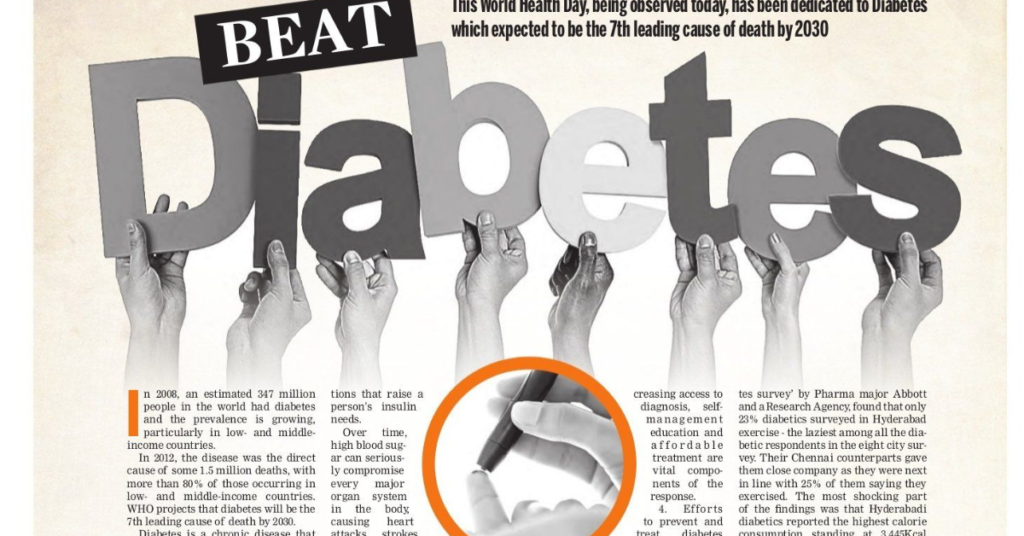n 2008, an estimated 347 million- people in the world had diabetes and the prevalence is growing. needs. particularly in low- and middle- income countries.
In 2012, the disease was the direct cause of some 1.5 million deaths, with more than 80% of those occurring in low and middle-income countries. WHO projects that diabetes will be the 7th leading cause of death by 2030.
Diabetes is a chronic disease that occurs either when the pancreas does not produce enough insulin or when the body cannot effectively use the in- sulin it produces. Insulin, a hormone that regulates blood sugar, gives us the energy that we need to live. If it can not get into the cells to be burned as energy sugar builds up to harmful lev els in the blood.
TypesThere are two main forms of the diabetes. People with type 1 diabe tes typically make none of their own insulin and therefore require insulin injections to survive. People with type 2 diabetes, the form that com prises some 90 per cent of cases, usually pro duce their own insu lin, but not enough or they are unable. to use it properly. People with type 2 diabetes are typi cally overweight and sedentary, 2 conditions that raise a person’s insulin needs.
Over time, high blood sug ar can serious ly compromise every major organ system in the body causing heart attacks, strokes, nerve damage, kid ney failure, blindness, impotence and infections that can lead to amputations.
This World Health Day, the focus is on diabetes because:
The diabetes epidemic is rapidly increasing in many countries, with the documented increase most dramatic in low and middle-income countries.
A large proportion of diabetes themselves cases are preventable. Simple lifestyle measures have been shown to be ef-campaign: fective in preventing or delaying the onset of type 2 diabetes. Maintaining normal body weight, engaging in regular physical activity, and eat- ing a healthy diet can reduce the risk of diabetes.
Diabetes is treatable. Diabetes can be controlled and managed to prevent complications. Increasing access to diagnosis, self- management education and affordable treatment are vital components of the response.
- Efforts to prevent and treat diabetes will be important to achieve the global Sustainable Development Goal 3 target of reducing premature mortality from non-communicable diseases (NCDs) by one-third by 2030. Many sectors of society have a role to play, including governments, employers, educators, manufacturers, civil society, private sector, the media and individuals themselves.
Goals of the World Health Day 2016
campaign: Increase awareness about the rise in diabetes, and its staggering burden and consequences, in particular in low-and middle-income countries
Trigger a set of specific, effective and affordable actions to tackle diabetes. These will include steps to prevent diabetes and diagnose, treat and care for people with diabetes; and
Launch the first Global report on diabetes, which will describe the burden and consequences of diabetes and advocate for stronger health systems to ensure improved surveillance,; enhanced prevention, and more effective management of diabetes.
The recent survey carried out simultaneously in Mumbai, New Delhi, Lucknow, Bengaluru, Trivandrum and Hyderabad during June-August revealed how Hyderabadi’s suffering from Type 2 diabetes seldom exercise.
Survey Titled called
Survey Titled called Food, Spikes and Diabetes survey by Pharma major Abbott and a Research Agency, found that only 23% diabetics surveyed in Hyderabad exercise-the laziest among all the dia betic respondents in the eight city sur vey. Their Chennai counterparts gave them close company as they were next in line with 25% of them saying they exercised. The most shocking part of the findings was that Hyderabadi diabetics reported the highest calorie consumption standing at 3,445K cal per day, again the highest among the diabetic respondents in the eight city survey. Their high eating habits was followed closely by their Kolkata coun terparts with 3,256Kcal per day. It is not just the calorie-laden meals, what’s worse was the diabetics in the city were found maintaining a wide gap between waking up and eating their breakfast at an average time-gap of 3.05 hours (longest duration followed closely by their Kolkata counterparts with 2.45 hours). They also ate only three meals, contrary to what experts would suggest for such patients.
“For diabetics, our advice alwayshas been not just to keep count of their cal orie intake but break-down their three meals into five-8-9am for breakfast, mid-morning snack at 11am, lunch, midevening snack at around 4pm fol lowed by dinner at around 8pm. This is because when the gap between two meals increases, it increases the hun ger leading to more eating and calorie intake,” said Dr Srinagesh.
He added that for a diabetic, 25-30k Cal per kg of body weight is the recommended intake. “Those still confused on how to measure calorie intake, they can refer to food atlas, which feature hundreds of foods eaten across regions in various portion sizes along with main nutritional values,” he advised

